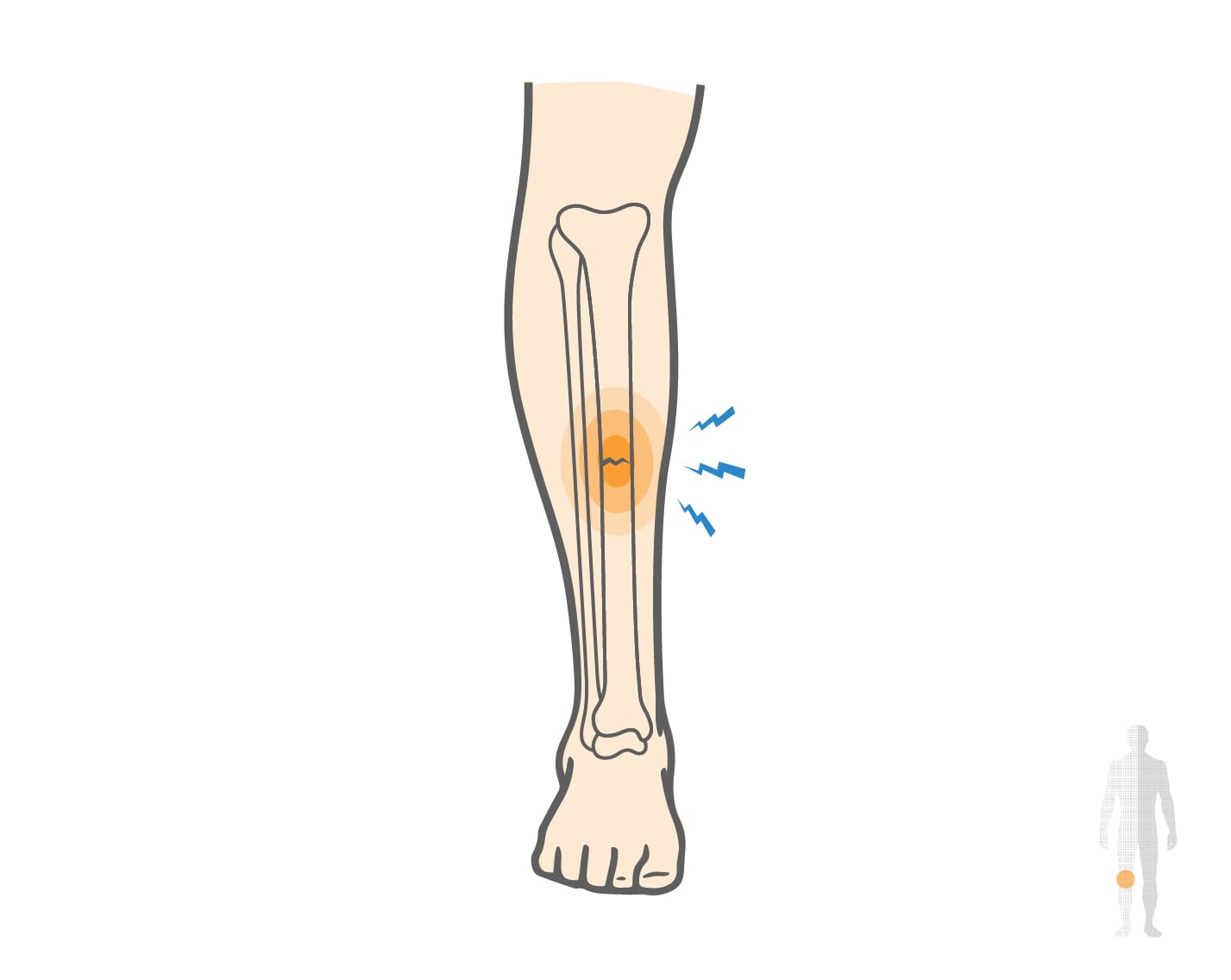A stress fracture, sometimes called a hairline fracture, is a small crack that doesn’t go all the way through your bone. Stress fractures frequently occur in the tibia, the largest of the two bones that make up your shin. This injury, common among athletes, is usually caused by overuse and can significantly interfere with exercise and sports activity.
Stress Fracture of the Tibia Causes, Symptoms & Treatment
A stress fracture, sometimes called a hairline fracture, is a small crack that doesn't go through your bone. Stress fractures frequently occur in the tibia, the largest of the two bones that make up your shin. This injury, common among athletes, is usually caused by overuse and can significantly interfere with exercise and sports activities
Overview
Overview

What causes Stress Fracture of the Tibia?
Stress fractures of the tibia are typically caused by too much stress placed on the tibia and surrounding muscles. This injury usually happens due to repetitive, high-impact exercise over a long period of time. Athletes may be at greater risk when they initiate a new training program or increase the volume or intensity of their normal running or exercise regimen. A stress fracture can also happen when the tibia is weakened due to low bone density (osteoporosis) or poor nutrition.
Runners and athletes who play high impact sports are at greatest risk for this injury. Stress fractures of the tibia are most common in these sports:
• Short distance running/sprinting
• Cross country running
• Basketball
• Soccer
Symptoms
Pain is the most common symptom of a stress fracture of the tibia. Pain usually starts gradually, and becomes localized on a small area of the shin. Typically, pain is first noticed toward the end of intense exercise, but gradually begins to occur earlier on. Common symptoms also include:
• Pain that gets worse with activity
• As the condition progresses, pain whose intensity and duration gradually increase
• Localized swelling
When to see a doctor
If your pain is localized in one part of your shin and continues to get worse, you should see your doctor for an examination. Your doctor will examine your shin and ask you to identify the focal area of pain and whether it gets worse with activity. An x-ray may be ordered, though it’s important to understand that because stress fractures may be very small, they do not always show up on an x-ray, especially soon after the injury. Other imaging tests, such as a bone scan or magnetic resonance imaging (MRI) test, may also be ordered to help confirm the diagnosis.
Non-operative treatment
Treatment for a stress fracture of the tibia focuses on pain relief and allowing the tibia to heal. This can usually be accomplished through non-surgical treatments. Conservative treatments include:
• Rest from activities and sports that place stress on the lower leg.
• Wearing a walker boot, with or without crutches, until pain resolves
• Applying ice for 15 minutes two or three times daily, especially after any activity
• Nonsteroidal anti-inflammatory drugs (NSAIDs), such as ibuprofen and naproxen, to help relieve pain and inflammation
• Increasing calcium in your diet (e.g. from foods like broccoli, yogurt, cheese, and dairy)
Try these exercises to help address your condition:
Below is a PDF of the Exercise Program
Surgical Treatment
Surgery is generally not needed for a stress fracture of the tibia. In very rare cases, your doctor will advise if surgery is a treatment option you should consider.
Recovery
Rest from activities that place stress on your tibia, giving it time to heal, will be the most important part of your recovery. If you’re a runner, that may mean no running for four to six weeks, and often several months. Your doctor and physical therapist can guide you on gradual return to play, such as less intense and frequent activity, and running on softer surfaces. Substituting less stressful activities, like swimming, into your exercise regimen can help you stay active and build strength during your rehabilitation period. Physical therapy exercises to strengthen muscles and tendons around the tibia will also be an important part of your recovery. Athletes will be at greater risk for recurrent fractures, so taking steps like proper warm up and cool down as well as a diet rich in calcium will be important.
GET BACK TO WHAT YOU LOVE. FASTER
Sources
https://www.healthline.com/health/hairline-fracture
https://www.verywellhealth.com/stress-fractures-of-the-tibia-3119335
https://online.boneandjoint.org.uk/doi/pdf/10.1302/0301-620x.40b2.227
https://www.ncbi.nlm.nih.gov/pmc/articles/PMC5359760/
https://www.runnersworld.com/advanced/a20800688/a-stress-fracture-primer/
Frequently Asked Questions
What are the common symptoms of a tibial stress fracture?
Typical symptoms include localized pain along the shin, swelling, tenderness to touch, and discomfort that worsens with physical activity and improves with rest.
Who is most at risk for developing a tibial stress fracture?
Athletes are at higher risk, especially runners or individuals who rapidly increase their training intensity or volume. People with low bone density or poor nutrition are also more susceptible.
How is a stress fracture of the tibia diagnosed?
A doctor may confirm the presence of a stress fracture by combining physical examination, patient history, and imaging tests like X-rays or MRI.
What is the typical treatment for a tibial stress fracture?
Treatment usually includes rest, avoiding high-impact activities, nutritional support, and sometimes physical therapy. In more severe cases, immobilization or further intervention may be needed.

